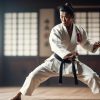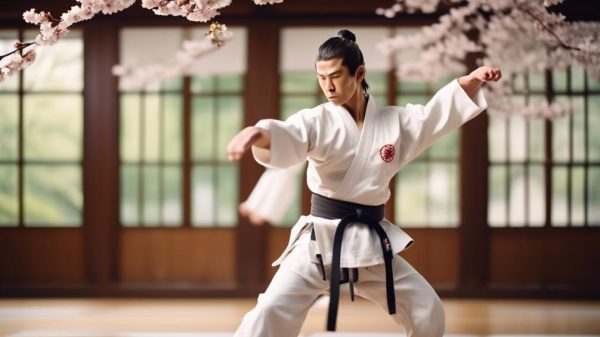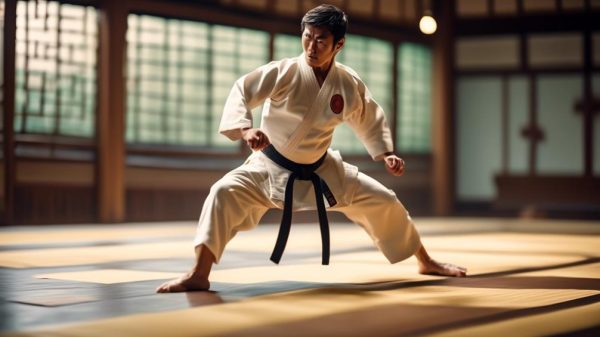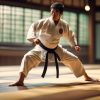Aikido is a Japanese martial art using the energy of attacks to safely counter opponents. Ikkyo techniques control the elbow joint and practice this.
Partners train ikkyo methods slowly and precisely. One grasps an arm to initiate the attack, the defender blends motions to unbalance and secure the elbow in response.
Focus lies less on speed and strength than unity, awareness, and flow between participants. Leading attackers gently to the ground avoids harm while teaching lessons.
Ikkyo wrist defenses display aikido ideals of peaceful resolution and redirecting negative intention. Mastering ikkyo takes patience, persistence and compassion along the lifelong path.
Understanding Ikkyo Technique
Understanding the foundational Ikkyo technique holds great importance in Aikido for effectively countering wrist grabs.
This technique enables redirecting an attacker’s force while maintaining control through precise footwork and body alignment.
In the realm of martial arts, Ikkyo serves as a cornerstone for defending against wrist grabs, embodying the essence of Aikido’s philosophy: harmonizing with your opponent’s movements to subdue aggression without causing harm.
It’s essential to note that Ikkyo encompasses a holistic approach involving the entire body when dealing with wrist grabs.
Whether facing a one-handed or two-handed grab, the technique remains consistent—blending with the attack, pivoting the body to align with the opponent, and extending their arm while keeping the own elbow down and in.
This creates an imbalance, neutralizing the threat and positioning for control.
Mastering Ikkyo not only paves the way for advanced Aikido techniques but also forms the basis for these advanced skills.
Therefore, focusing on the nuances of Ikkyo is crucial. Cultivating the seamless integration of footwork, body alignment, and the subtle redirection of force defines Aikido’s approach to self-defense and leads to mastery of this foundational skill.
Identifying Common Wrist Grabs
Understanding the different types of wrist grabs is essential for effectively applying Aikido Ikkyo techniques.
Recognizing your opponent’s attack style is crucial in deploying the appropriate Aikido wrist locks and defenses.
Let’s explore the common wrist grabs you may encounter and how they can test your Aikido skills:
- Single Wrist Grab: An opponent seizes one of your wrists with one hand, requiring a swift defense against this straightforward attack.
- Cross Wrist Grab: Your opponent’s hand crosses over to grab the opposite wrist, necessitating a keen observation of their body movement to counter effectively.
- Two Hands Grabbing One Wrist: This grip involves both of your opponent’s hands on a single one of your wrists, intensifying the need for a powerful Ikkyo response.
- Hands Grabbing Two Wrists (Ryotetori): When your opponent grabs both of your wrists, known as Ryotetori, it demands a nuanced defense.
Mastering these scenarios ensures that your Aikido techniques aren’t just theoretical knowledge but practical skills.
Swiftly discerning between these grabs will significantly enhance your defenses, making you a formidable Aikido practitioner.
Positioning for Effective Defense
To effectively defend yourself, it’s crucial to position your stance correctly. By anticipating your attacker’s movements, you gain the upper hand in neutralizing their efforts.
Utilize your body’s dynamics to your advantage, redirecting their force with precision. This proactive approach allows you to establish a solid defense and stay ahead of the game.
Correct Stance Alignment
Mastering the proper stance in Aikido Ikkyo is essential for effectively defending against wrist grabs. It’s not just about looking poised; your stance acts as the foundation for control and balance.
When dealing with Grabs — Two Hands Grabbing One or any Defenses Against Wrist attacks, keep in mind the following:
- Establish a strong base: Your stability hinges on your footing.
- Relax your posture: Tension can impede the flow of the technique.
- Align your body: Proper positioning is crucial for redirecting your opponent’s energy.
- Neutralize aggression: Use your stance to effectively absorb and redirect force.
Anticipating Attacker’s Move
Understanding the stance is crucial for defense, but predicting the attacker’s next move is even more essential for an effective response.
In Aikido, when defending against wrist grabs with the Ikkyo technique, anticipating the opponent’s actions is vital.
A skilled martial arts instructor emphasizes the importance of reading the attacker’s body language to make preemptive adjustments.
| Factor | Benefit |
|---|---|
| Awareness | Anticipate attacks |
| Reading Body Language | Achieve optimal positioning |
| Adjusting Stance | Execute techniques efficiently |
| Redirecting Energy | Gain a strategic advantage |
The goal is not merely to react but to control the situation. By foreseeing grabs and strategically countering them, you can maintain the upper hand.
Leveraging Body Dynamics
In Aikido Ikkyo, effectively positioning your body can redirect an opponent’s momentum to your advantage, laying the groundwork for a successful defense.
When executed with precision, this technique shouldn’t only be used to break free from the grip but also to gain control over the attacker, potentially leading to the application of elbow locks or other martial arts maneuvers.
Key Points to Keep in Mind:
- Skillfully redirect the attacker’s energy through strategic movement.
- Counteract the grab by adjusting your position to exert maximum control.
- Preserve your balance to maintain the upper hand.
- Practice transitioning into elbow locks as a continuation of asserting control.
Executing the Ikkyo Movement
To become proficient in the Ikkyo technique, it’s essential to understand and master the foundational elements. This includes precise footwork, proper body alignment, and executing the movements with fluidity.
When facing a wrist grab, the objective is to redirect the assailant’s energy, using their momentum against them.
Enhance the effectiveness of Ikkyo by practicing seamless transitions from fluid movements to control and immobilization techniques.
Ikkyo Technique Fundamentals
Fundamentals of Mastering the Ikkyo Technique
To effectively redirect your attacker’s energy using the Ikkyo technique, it’s essential to align your body and feet properly.
Precision and control are fundamental in Aikido’s Ikkyo technique, prioritizing safety and injury prevention.
Positioning: Stand with your feet shoulder-width apart and slightly bent knees.
Grip: Maintain a secure hold on your attacker’s wrist while keeping your own wrist straight.
Balance: Shift your weight to ensure control and stability.
Movement: Lead with your hips while gliding forward or to the side.
To refine your movements and receive additional guidance, seek advice from a seasoned martial arts instructor. Diligent practice of this foundational skill will enhance your Aikido journey.
Wrist Grab Counters
Learn to defend against wrist grabs effectively by mastering Aikido’s Ikkyo technique. This technique involves using swift circular movements to redirect your attacker’s force and gain control.
To become proficient in countering wrist grabs, immerse yourself in martial arts techniques and training. Focus on leveraging your opponent’s momentum, applying wrist manipulation for discomfort, and disrupting their balance with adept footwork and body positioning.
Refine your skills through repetition in martial arts classes and training with appropriate equipment. It’s essential to practice under the guidance of a trained instructor to advance your skills effectively.
With dedication, Aikido’s Ikkyo technique will become a valuable asset in your self-defense arsenal.
Enhancing Ikkyo Efficacy
Enhancing the Effectiveness of Aikido Ikkyo Technique
Improve your Aikido Ikkyo technique by engaging in smooth circular movements that counteract an opponent’s force during a two-handed arm grab. These movements form the foundation of Aikido and martial arts techniques, emphasizing harmony and efficiency.
To refine your Ikkyo further, consider these essential elements:
- Stay relaxed and centered to maintain control.
- Master footwork and coordination for seamless execution.
- Adapt the technique to fit your unique capabilities.
- Practice regularly under a trained instructor to ensure safety.
Key Points for Control
To effectively control an assailant during a wrist grab, it’s essential to apply Aikido Ikkyo with precise wrist manipulation and deliberate footwork.
Mastering this fundamental Aikido technique not only neutralizes the grab but sets the foundation for more advanced martial arts techniques and training.
As you practice, focus on redirecting your opponent’s energy rather than clashing head-on.
Utilize practice mats and ensure you’re supervised by a trained instructor to perfect your movements. The goal is to maintain control while minimizing harm to both parties involved.
Remember, Aikido isn’t just about physical maneuvers—it’s a strategic art form. Your footwork should be as intentional as your wrist manipulation, creating a dynamic flow that keeps the attacker off-balance.
This approach not only reinforces and supplements your physical skills but also your mental acuity.
Every technique you learn is for informational purposes, to be adapted to real-life scenarios.
Aikido training isn’t about brute force; it’s about the economy of motion and the judicious use of leverage.
Equip yourself with the right Arts Training Equipment, embody the principles of Aikido, and your ability to control an assailant will grow exponentially.
Training Drills for Proficiency
Building on the foundation of controlling an assailant with Aikido Ikkyo, let’s now focus on sharpening your skills through targeted training drills designed to increase your proficiency.
Remember, the techniques and training exercises should be supervised by a trained instructor who can provide immediate feedback and ensure your safety.
To hone your Aikido mastery, incorporate these drills into your routine:
- Repetition Drills: Consistently practice the Ikkyo technique from various wrist grabs to build muscle memory. Start slow, focusing on proper body alignment and footwork, then gradually increase speed and fluidity.
- Balance and Stability: Work on establishing a strong base by practicing your stance and center of gravity control. Use balance exercises to enhance your ability to redirect your opponent’s energy efficiently.
- Response to Different Angles: Train with partners attacking from multiple angles to adapt the Ikkyo application. This will prepare you to respond to diverse scenarios, sharpening your reflexes and versatility.
- Multiple Attacker Scenarios: Engage in controlled sparring sessions with several partners to simulate real-life situations, improving your spatial awareness and decision-making under pressure.
The information on these pages is for guidance; real-world application requires diligence and a nuanced understanding of martial dynamics. Aim for crisp execution and remain attentive to every detail in your Aikido journey.
Real-World Application Tips
When encountering a wrist grab, maintaining your posture and stability is essential for a successful Aikido Ikkyo defense.
Aikido goes beyond physical movements; it’s about the unity of mind and body. While training, concentrate on refining your footwork and body positioning.
This practice isn’t just a drill; it prepares you for unexpected real-life situations.
In real-world scenarios, it’s crucial to adapt Aikido techniques to dynamic situations. Wrist grabs can occur from any direction, and attackers often don’t follow scripted training routines.
The principles learned from credible sources come into play here. Utilize your understanding of Aikido’s flow to redirect your opponent’s energy and maintain control, even in forceful or two-handed grabbing situations.
In critical moments, employing proper technique can determine whether you regain your freedom or get overpowered.
Regularly practicing the Ikkyo defense will engrain it into your muscle memory, enabling quick and effective responses.
Mastery extends beyond techniques and training; it also involves the ability to remain composed and assertive when it truly matters.
Enhancing Ikkyo With Variations
Incorporating variations into your Ikkyo technique can improve its adaptability and effectiveness in different self-defense situations.
Aikido, known for its fluidity and precision, provides a method to use an attacker’s energy against them. To master this art, it’s essential to delve into the nuances of techniques and training.
Consider the following variations to refine your Ikkyo:
- Alter hand positions: Changing your grip can enhance control over the assailant.
- Adjust angles: Small shifts in your stance or approach can significantly impact the outcome.
- Combine with other techniques: Blend into other Aikido moves to keep your opponent off-balance.
- Manage multiple assailants: Utilize Ikkyo to redirect one attacker’s energy, creating space and time to deal with others.
Frequently Asked Questions
What Are the Three Aikido Techniques?
You are honing your skills in Aikido’s fundamental techniques: Ikkyo, Nikyo, and Sankyo. These techniques are deeply rooted in martial philosophy, emphasizing precise footwork and breath control while respecting Aikido’s historical and spiritual significance. Take care and practice safely.
How to Do Ikkyo Aikido Lessons?
To master Ikkyo, the art of balance disruption and energy redirection, it’s important to focus on precise joint manipulation, appropriate training attire, and an understanding of Aikido philosophy, Dojo etiquette, and Uke cooperation. Understanding these aspects will be crucial for successfully learning and applying Ikkyo techniques.
What Is the First Control in Aikido?
The initial technique in Aikido involves using blending motions to harness energy, reflecting the martial philosophy of the art.
This practice typically involves working with a partner, known as uke, and adhering to the respectful customs of the dojo while wearing appropriate training attire. Proficiency in Aikido begins with mastering these foundational principles.
Can Aikido Be Used for Self Defense?
Aikido is a practical and philosophical approach to self-defense that emphasizes awareness, non-aggressive defense, martial effectiveness, and technique adaptation for personal protection.
It can equip individuals with the skills and mindset necessary to defend themselves in a variety of situations.









